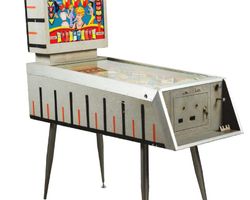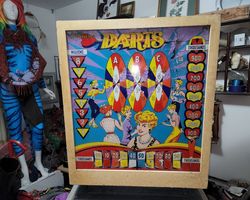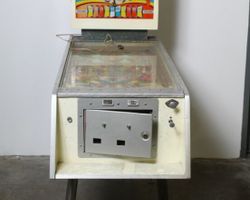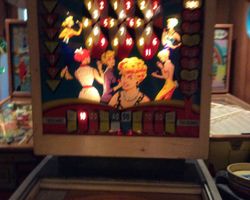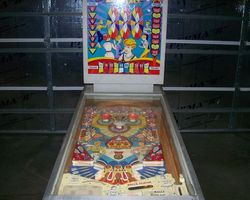
Average Prices: USD $300 to $900
Produced: June, 1960
Machine Type: Electro-mechanical
Players: 1
Design by: Steve Kordek
Art by: George Molentin
Williams Electronic Manufacturing Company introduced "Darts" in June 1960, an electro-mechanical (EM) pinball machine that offered players a novel experience rooted in a familiar pub game. The machine’s theme directly mirrored its namesake, challenging players to "throw" virtual darts by hitting targets on the playfield. This period marked a transitional phase for Williams, as it sought to innovate beyond established designs, moving towards a new aesthetic and player interaction.
The design and production of "Darts" were significant for several reasons. While some early production units initially utilized a standard woodrail cabinet, Williams soon introduced a custom-shaped cabinet specifically for this game, heralding what they termed "Styling of the 60's." This new cabinet featured anodized aluminum trim and tapered tubular chromium steel legs, giving the machine a distinct, modern appearance for its era. A unique addition was a shelf with a cigarette holder, which also increased the cabinet's length by six inches, catering to social play. The internal structure also saw an upgrade, with the plywood bottom increasing from 1/4-inch to 3/4-inch thickness, enhancing durability. George Molentin is credited with the machine's artwork, contributing to its vibrant visual appeal. The internal playfield drawing indicates S. Ahlborn made and signed changes, dated February 26 and 29, 1960, providing insight into the detailed refinement process before release. "Darts," model number 236, officially debuted on June 13, 1960, marking it as a notable release during this period of cabinet innovation for Williams.
Signature Features and Design
"Darts" stood apart visually due to its pioneering cabinet design. The shift from the traditional woodrail to a sleeker, custom-shaped form with anodized aluminum trim and slender, tapered chromium steel legs was a bold statement from Williams. This design choice was not merely cosmetic; it aimed to offer a more contemporary aesthetic for the 1960s. The inclusion of a small shelf with a cigarette holder, while perhaps quaint by modern standards, reflected the social context of arcades and amusement parlors of the time, providing a convenient space for players' drinks or cigarettes. This detail, alongside the increased cabinet length, contributed to a more immersive and comfortable player stance.
The artistic direction of "Darts," spearheaded by George Molentin, ensured the machine's theme was well-integrated into its visual identity. The backglass, illuminated by internal lights, depicted a series of dartboards, crucial for tracking player progress. This visual element tied directly into the gameplay mechanics, where hitting specific playfield targets would light up corresponding segments on these backglass dartboards. The overall colorful and engaging artwork contributed significantly to the machine's appeal, helping to offset any perceived stylistic drawbacks of the new cabinet by some contemporary observers.
Playfield and Mechanics
The "Darts" playfield is a carefully arranged layout designed to emulate the progression of a dart game, challenging players with precise shots and strategic nudging. Two flippers guard the bottom, serving as the primary means of ball control and shot execution. Above the flippers, a pair of slingshots provide dynamic rebound action, deflecting the ball unpredictably and keeping the pace lively.
The core of the playfield is populated with six standup targets, strategically placed to represent the numbered sections of a dartboard. Players aim to hit these targets, typically labeled 1 through 9, to progress through the game's objectives. Three pop bumpers are distributed across the upper playfield, delivering chaotic yet exhilarating bumper action, sending the ball ricocheting off targets and into scoring zones. Further enhancing the interactive experience are five kick-out holes, each offering a distinct challenge and reward upon successful entry. A central gobble hole also features prominently, a high-risk, high-reward target that is critical for activating special game features.
The playfield's aesthetic aligns with the dartboard theme, featuring clear demarcations and vibrant colors that guide the player's eye towards the various targets. The artwork on the playfield complements the backglass, with bold numbers and thematic elements reinforcing the game's identity. The lighting on the playfield, while simple by later solid-state standards, effectively highlights active targets and scoring opportunities, contributing to player immersion and signaling progress. The overall design philosophy balances direct shot-making with the unpredictable nature of an EM machine, demanding both skill in flipping and a nuanced understanding of ball physics for optimal scoring.
Gameplay Dynamics
"Darts" employs a straightforward yet compelling gameplay progression centered around its theme. The primary objective is to complete "dartboards" by hitting specific numbered targets (1-9) on the playfield. Each successful hit registers on the backglass, illuminating sections of the virtual dartboards. As players hit more targets and complete sequences, they work towards lighting the crucial gobble hole for special awards.
The scoring system is based on accumulated points for hitting targets, bumpers, and entering kick-out holes. The maximum displayed point score for a single game is 8,990,000 points, a substantial figure for an early 1960s EM machine, encouraging high-score competition. Beyond raw points, the game's depth lies in its strategic objectives. Successfully hitting the necessary targets to complete a dartboard on the backglass activates a special award, often tied to lighting the gobble hole. When the gobble hole is lit, plunging the ball into it offers significant rewards, including bonus points and potential replays. Additionally, rollovers positioned between the flippers can also contribute to lighting the gobble hole, offering up to three replays, providing a lifeline for players on a good run.
Player strategy in "Darts" involves a blend of precise flipping to hit specific standup targets and skillful nudging to influence the ball's trajectory, particularly towards the kick-out holes and gobble hole. Given the nature of EM machines, mastering the art of controlled nudging is essential to keep the ball in play and guide it towards high-value targets. The presence of the gobble hole, while offering a tempting reward, also presents a risk, as it can end a ball quickly if misjudged. This balance of risk and reward, combined with the clear objective of completing the dartboards, provides a satisfying gameplay loop that encourages repeat plays. The game's dynamics demand consistent focus and adaptation to the ball's movement, making each play session engaging.
Reception and Legacy
"Darts" has largely garnered a positive reception from the pinball community, particularly among enthusiasts of electro-mechanical machines from the early 1960s. Its gameplay is frequently described as simple yet highly engaging, demanding active player participation through precise flipping and well-timed nudges. Reviewers often highlight the satisfying flow of the game, with its well-placed saucers and multiple objectives providing a continuous sense of purpose on the playfield. The game's balance, reflective of its 1960s design, is sometimes noted as distinct, offering a different feel compared to later eras.
The artwork, particularly George Molentin's backglass, is consistently praised as colorful and visually appealing, often cited as a strong asset that enhances the machine's overall charm. The theme itself is considered well-executed, integrating effectively with the game's mechanics. For many, "Darts" evokes a strong sense of nostalgia, representing the pinball experiences of their youth and embodying the spirit of its creators. Its perceived durability and reliability are also positives, with some owners reporting decades of trouble-free operation.
However, "Darts" is not without its limitations, though these are few. One recurring point of frustration for some collectors is its relative scarcity. While appreciated, Williams EM machines from this period are less common in collections compared to those from other manufacturers, making "Darts" a challenging find. A minority of players express a dislike for gobble holes in general, finding them counter to the objective of maximizing ball time, even when activated for special awards. There has also been some discussion within the community regarding the precise attribution of its design, reflecting a broader challenge in documenting the individual contributions to many earlier pinball machines. Finally, while the "Styling of the 60's" cabinet was innovative at the time, some modern observers find its aesthetic dated or "ugly," although this is often offset by the quality of the backglass art.
Despite these minor critiques, "Darts" maintains a strong reputation. Its influence lies in its successful blend of a simple, approachable theme with a robust, engaging EM playfield. It stands as a testament to Williams' innovation in cabinet design during a pivotal era for pinball, showcasing an early attempt at modernizing the machine's physical presentation. Its enduring appeal underscores the lasting enjoyment derived from well-designed electro-mechanical gameplay, solidifying its place as a cherished example from the early 1960s in pinball history.
Sponsored Links
 Ebay Listings
Ebay Listings
 Auction Results
Auction Results
| Cost | Location | Date |
|---|---|---|
| USD $355 |  Minnesota, United States Minnesota, United States |
14 July, 2022 |
| USD $159 |  California, United States California, United States |
09 March, 2020 |
| USD $255 |  California, United States California, United States |
21 January, 2020 |
| USD $500 |  Kansas, United States Kansas, United States |
23 August, 2019 |
| AUD $1,800 |  South Australia, Australia South Australia, Australia |
11 September, 2018 |
| USD $325 |  Nevada, United States Nevada, United States |
28 January, 2018 |
| USD $575 |  California, United States California, United States |
30 May, 2016 |
| USD $465 |  Virginia, United States Virginia, United States |
05 December, 2015 |
| USD $655 |  Michigan, United States Michigan, United States |
20 January, 2013 |
| USD $399 |  Missouri, United States Missouri, United States |
09 February, 2012 |


Private Policy · Search Website · Contact Us
As an eBay Partner, we may earn a commission from qualifying purchases made through links on this site, at no additional cost to you.
All trademarks and copyrighted materials remain property of their respective owners. All other content copyright 2007 - 2025 Pinpedia.

